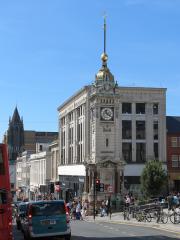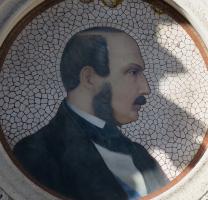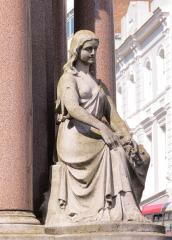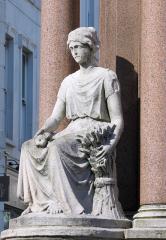
Brighton Jubilee Clock Tower.
Brighton’s Jubilee Clock Tower is a landmark for visitors to the town, being on the direct walk down the hill from the station to the shore, where the main road – Queen’s Road becoming West St – crosses the main shopping thoroughfare of North Street, which to the right becomes the lesser Dyke Road.
Prince Albert portrait roundel. 
The tower, some 75 ft tall, is square in plan, and is made of several stages. Above the steps which form the base, there is a shrine-like construction of pillars and a pediment on each side known architecturally as an aedicule. Each of these four sides, then, contains a roundel showing a Royal portrait. Queen Victoria faces up the hill to the north, so visitors see her as they come down xx St; Prince Albert faces the sea, so day-trippers returning from the sea to the station see him to advantage; and on the other two sides, are the then Prince and Princess of Wales (i.e. Prince Edward and Princess Alexandra). The portraits seem to be painted on glazed tile, and have a white mosaic backing, the first line of which goes around the head and the rest splodged in, a Roman fashion of laying tiles – but the shapes are irregular. Above these, the open pediments have small sculptures of ships’ prows surmounted by Classical dolphins, with ornamental foliage, and on the top are ogee-shaped pots.
Two of the figure sculptures, perhaps Spring and Autumn. 

The corners of the monument, between the aedicules and partially shielded from the weather by the clustered pillars of pink granite, contain four seated allegorical girls, statues in Portland stone. They are lightly dressed, short-sleeved on or off the shoulder above, with long skirts below, in a Greek chiton-like Victorian Classicism. Their hair is extremely Victorian, whether piled up on let down, and in one case with a bonnet. They hold a variety of vegetative accoutrements, and are likely representative of the four Seasons; for example the one holds a sheaf of corn in one hand and has an apple or similar fruit in her lap. All have seen a degree of wear and tear.
So much for the lower, first stage of the tower. Above rises the second stage, being the relatively tall shaft of the tower, with tin Romanesque window on each side, and a festoon of flowers beneath a square blank light, and then the clock face on each side. Each clock face is dated 1887 (the year of Queen Victoria’s Jubilee, though the clock tower was put up in 1888), and the word ‘Willing’, which is actually the name of the donor of the Jubilee tower. To the corners at this level are square pillar capitals, sort of Corinthian, and hanging flowers, the carving being somewhat decayed.
Next, an entablature, rather broad Italianate shelf, and the third stage, semi-battlemented, with pots repeating those found below, but bigger, and on each face, a cartouche of arms with two supporters being a pair of putti (wingless cherubs), naked, large-headed and each pair clutching between them the two ends of a festoon of carved flowers.
Behind, the smaller final stage, octagonal now, with four more tall windows, terminates in a fine octagonal dome of painted and gilt copper, covered in peacock-feather designs; the top of this has an open latticework supporting a crown, and then a golden ball on a shaft rising to a weathervane; this used to rise and fall with the time, but the mechanism was never so robust and for most of the clocktower’s lifetime, it has not worked.
The artists who made the sculpture and the roundel portraits of the Royals on the Brighton Jubilee clock tower are anonymous, which is generally the case with such architecture. However the architect of the tower itself is recorded as John Johnson, he being a local man, it seems, and not the better-known eponymous London architect who built up the Marylebone Berners Estate as well as various country houses and civic buildings, or the other Victorian man, another Londoner, who worked with or for the civil engineer John Kelk, for example on Alexander Palace. But it seems our Brighton John Johnson was the architect of Gravesend’s Jubilee Clock Tower, a similar design but bigger and more Gothic, with sculptural portraits in the aedicules and no corner figures, and nearly certainly was the John Johnson who designed the slightly smaller tower at Surbiton which was put up to commemorate the coronation of Edward VII, rather late in 1908, and which old pictures show to have had standing corner figures, now lost.
There are a variety of clock towers with a similar look in various towns across England, the ultimate inspiration being doubtless Big Ben. Some serious architectural historians, above all Pevsner, have sniffed at the Brighton Clock Tower, but he was writing when the reaction to decorated buildings was still strong, and today we need to cherish our Victorian heritage, and I think most would see this light-hearted building as an asset. Anyway, Brighton’s Jubilee clock tower is a fine example of the breed, tall enough to be prominent, small enough to be intimate, and still today providing a landmark in the city centre.
Also in Brighton, Edward VII memorial and Queen Victoria statue
Back to January Sculpture of the Month // Onward to March
For another seaside clock tower, in Margate, see this page // Architecture and architectural sculpture // Sculpture in some English towns
Visits to this page from 1 Feb 2017: 4,759